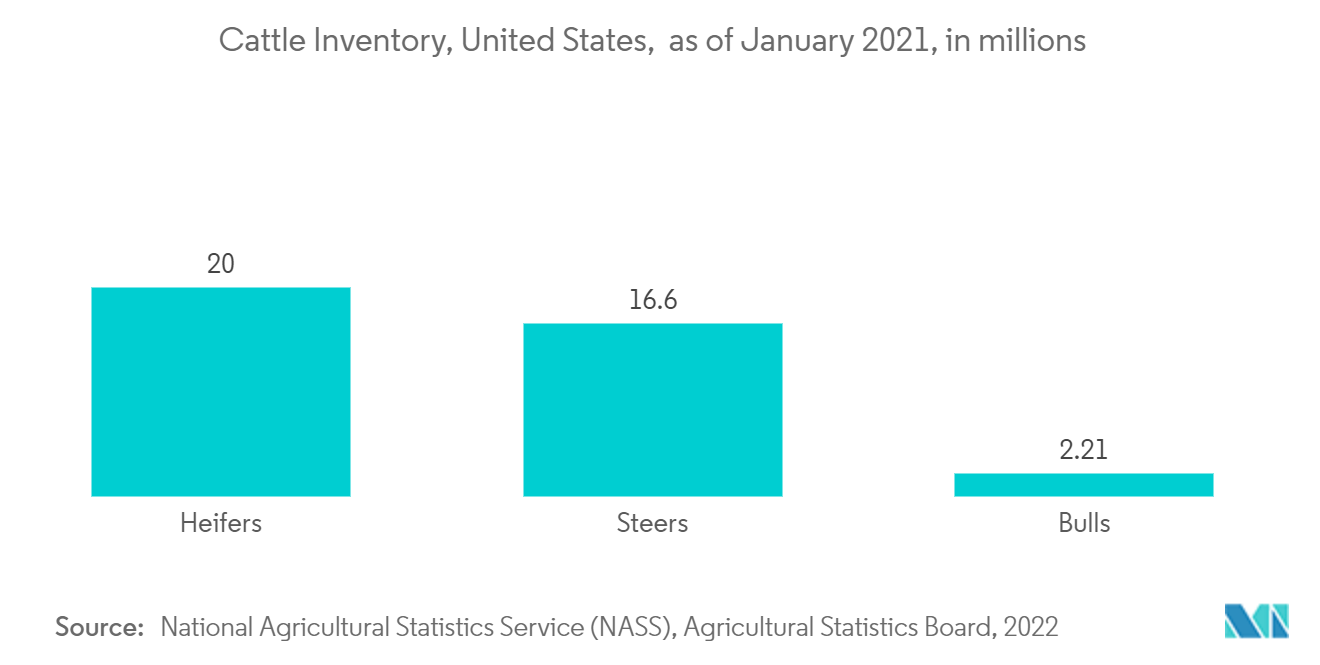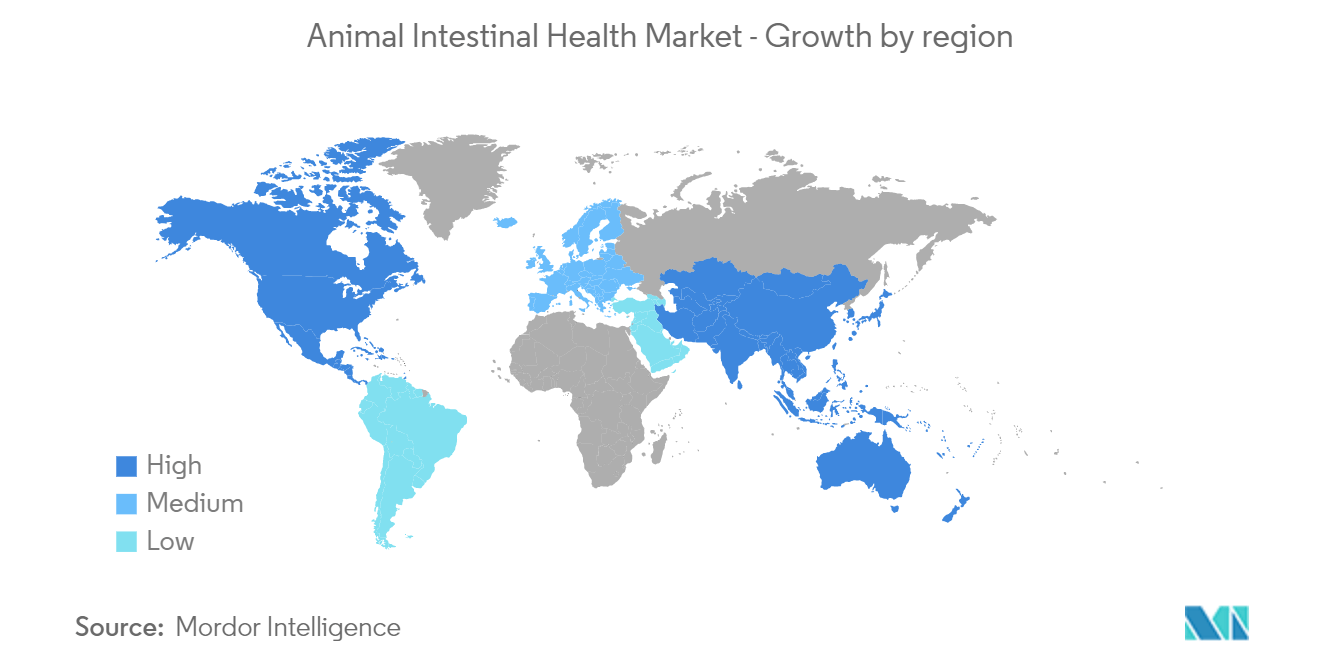Market Trends of Global Animal Intestinal Health Industry
This section covers the major market trends shaping the Animal Intestinal Health Market according to our research experts:
The Probiotics Segment is Expected to Hold a Major Market Share in the Animal Intestinal Health Market.
Probiotics are a major fraction of the feed supplements used in the livestock industry. Probiotics are microbial feed supplements that, when consumed adequately, bestow health benefits on the host. An article published in the Journal of Basic and Applied Zoology in October 2021 discussed the drawbacks of using antibiotics to prevent animal diseases and how antibiotics could be replaced with probiotics. Probiotics could be beneficial in the improvement of health and growth of livestock and fish. Another article published in BioMed Central (BMC) Zoology in April 2021 conferred that probiotics help increase the rate of digestion in animals. The article proposed that probiotics can enhance broilers' cecal microorganism constitution and nutrient digestion. A research study published in the journal of Aquaculture in 2021 studied the effects of probiotics on the fish Tilapia. It concluded that they were vital in growth performance and nutrient utilization.
According to an article published in the journal of Sustainability in February 2020, probiotics are being increasingly used as a safe and viable alternative to antibiotics for increasing performance in livestock. The article showed that several health agencies worldwide have established and documented adequate safety protocols for probiotics development. As per the article in the Journal of Agriculture in October 2020, probiotics improved gut microbiota composition, immune response, nutrient digestibility and absorption, animal growth, and meat quality. The authors also suggested that further studies characterizing specific strains, identifying the optimal dosage, and understanding the network of interactions between probiotics and the gut microbiota could help formulate more effective probiotic mixtures for animal feed and meat products.
Another article published in the journal of Agriculture in October 2020 suggested that using probiotics in farm animals decreased morbidity and vitality, improved feeding behavior, and increased production yield. Also, probiotic use has expanded into the food industry due to its ability to inhibit a wide range of pathogenic microbes. Another article in the journal of Animals in October 2020 reviewed the effects of probiotics on poultry nutrition utilization, growth and laying performance, and gut health. The article showed that the probiotic supplement helped in the improvement of the body weight of the broiler chicken. The increase in the research activities concerning the use of probiotics and the helpful nature of probiotics is expected to propel the growth of the animal intestinal health market in the forecast period. However, the various regulations laid by the governments on the use of probiotics in the livestock industry are likely to hamper the market's growth.

North America is Expected to Hold a Significant Share in the Market and Expected to do Same in the Forecast Period (2022-2027).
The United States of America is one of the largest consumers of meat and dairy products. According to Organisation for Economic Co-operation and Development - Food and Agriculture Organization (OECD-FAO) agricultural outlook 2021, the United States consumed around 43,810 thousand tonnes of poultry, sheep, pork, beef, and veal, constituting around 34.43% of the total meat consumption in the world. A large amount of meat consumption by the United States is expected to propel the market's growth in the forecast period. According to the United States Department of Agriculture's Economics, Statistics and Market Information System, as of January 2022, the United States produced around 12,383 thousand metric tonnes of beef and veal, 12,478 thousand metric tonnes of pork, and 20,712 thousand metric tonnes of chicken. The large production volumes are mainly attributed to the increased consumption of meat products. As per the United States Department of Agriculture's Economic Research Service, the United States had produced over 2,26,258 million pounds of milk in the year 2021. The increased consumption of meat and dairy products requires the proper maintenance of the livestock.
As per the Cattle inventory released by the National Agricultural Statistics Service (NASS), Agricultural Statistics Board, United States Department of Agriculture (USDA) in January 2021, the United States had around 93.8 million cattle and calves, with beef cows at 31.2 million and milk cows at 9.44 million. The total number of heifers accounted for 20 million, with beef replacement heifers at 5.81, milk replacement heifers at 4.6 million, and other heifers at 9.58 million. The number of steers had increased from the previous year to 16.6 million, and the total number of bulls as of January 2021 was 2.21 million. The number of cattle and calves for the slaughter market in the United States was about 14.7 million, slightly increasing from 2020.
The United States Department of Agriculture (USDA), in 2021, showed that livestock and poultry accounted for over half of United States agricultural cash receipts, exceeding USD 100 billion per year. In its 2022 Feed Industry Stats, the American Feed Industry Association estimated that the total volume of feed consumption in the United States is projected to grow to 263.1 million tonnes in 2025 from 248.4 million tonnes in 2020, in the best case scenario. The huge production and consumption of meat and dairy products in the United States are expected to improve the livestock count in the region. The increasing livestock count and the associated animal feed required for the healthy maintenance of the livestock is likely to advance the expansion of the animal intestinal health market in the North American region.


